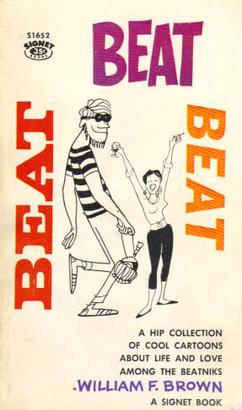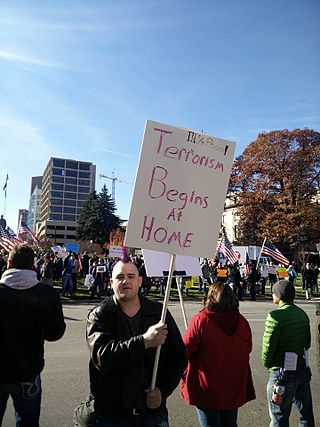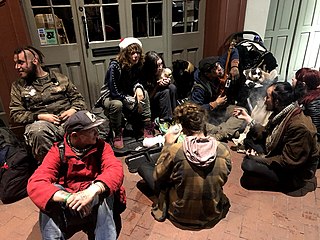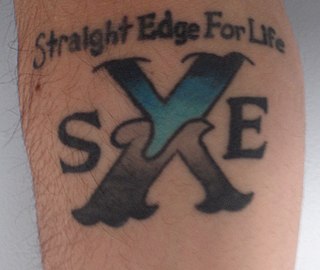Related Research Articles
Punk rock is a music genre that emerged in the mid-1970s. Rooted in 1950s rock and roll and 1960s garage rock, punk bands rejected the corporate nature of mainstream 1970s rock music. They typically produced short, fast-paced songs with hard-edged melodies and singing styles with stripped-down instrumentation. Lyricism in punk typically revolves around anti-establishment and anti-authoritarian themes. Punk embraces a DIY ethic; many bands self-produce recordings and distribute them through independent labels.

The punk subculture includes a diverse and widely known array of ideologies, fashion, and other forms of expression, visual art, dance, literature, and film. Largely characterised by anti-establishment views, the promotion of individual freedom, and the DIY ethics, the culture originated from punk rock.

A skinhead or skin is a member of a subculture that originated among working-class youths in London, England, in the 1960s. It soon spread to other parts of the United Kingdom, with a second working-class skinhead movement emerging worldwide in the late 1970s. Motivated by social alienation and working-class solidarity, skinheads are defined by their close-cropped or shaven heads and working-class clothing such as Dr. Martens and steel toe work boots, braces, high rise and varying length straight-leg jeans, and button-down collar shirts, usually slim fitting in check or plain. The movement reached a peak at the end of the 1960s, experienced a revival in the 1980s, and, since then, has endured in multiple contexts worldwide.

A hippie, also spelled hippy, especially in British English, is someone associated with the counterculture of the 1960s, originally a youth movement that began in the United States during or around 1964 and spread to different countries around the world. The word hippie came from hipster and was used to describe beatniks who moved into New York City's Greenwich Village, San Francisco's Haight-Ashbury district, and Chicago's Old Town community. The term hippie was used in print by San Francisco writer Michael Fallon, helping popularize use of the term in the media, although the tag was seen elsewhere earlier.

Beatniks were members of a social movement in the mid 20th century, who subscribed to an anti-materialistic lifestyle. They rejected the conformity and consumerism of mainstream American culture and expressed themselves through various forms of art, such as literature, poetry, music, and painting. They also experimented with spirituality, drugs, sexuality, and travel. The term “beatnik” was coined by San Francisco Chronicle columnist Herb Caen in 1958, as a derogatory label for the followers of the Beat Generation, a group of influential writers and artists who emerged during the era of the Silent Generation's maturing, from as early as 1946 to as late as 1963, but the subculture was at its most prevalent in the 1950s. The name was inspired by the Russian suffix “-nik”, which was used to denote members of various political or social groups. The term “beat” originally was used by Jack Kerouac in 1948 to describe his social circle of friends and fellow writers, such as Allen Ginsberg, William S. Burroughs, and Neal Cassady. Kerouac said that “beat” had multiple meanings, such as “beaten down”, “beatific”, “beat up”, and “beat out”. He also associated it with the musical term “beat”, which referred to the rhythmic patterns of jazz, a genre that influenced many beatniks.
Anarcho-punk is an ideological subgenre of punk rock that promotes anarchism. Some use the term broadly to refer to any punk music with anarchist lyrical content, which may figure in crust punk, hardcore punk, folk punk, and other styles.

A counterculture is a culture whose values and norms of behavior differ substantially from those of mainstream society, sometimes diametrically opposed to mainstream cultural mores. A countercultural movement expresses the ethos and aspirations of a specific population during a well-defined era. When oppositional forces reach critical mass, countercultures can trigger dramatic cultural changes. Prominent examples of countercultures in the Western world include the Levellers (1645–1650), Bohemianism (1850–1910), the more fragmentary counterculture of the Beat Generation (1944–1964), and the globalized counterculture of the 1960s (1965–1973). Countercultures differ from subcultures.

A subculture is a group of people within a cultural society that differentiates itself from the conservative and standard values to which it belongs, often maintaining some of its founding principles. Subcultures develop their own norms and values regarding cultural, political, and sexual matters. Subcultures are part of society while keeping their specific characteristics intact. Examples of subcultures include BDSM, hippies, hipsters, goths, steampunks, bikers, punks, skinheads, gopnik, hip-hoppers, metalheads, cosplayers, otaku, otherkin, furries, and more. The concept of subcultures was developed in sociology and cultural studies. Subcultures differ from countercultures.

Hardline is a subculture that has its roots in the vegan straight edge hardcore punk scene. It is commonly seen as a more extreme version of straight edge, with influences from deep ecology philosophy. From its outset, hardline adherents put out statements and literature pushing a biocentric view of the world, which advocated for veganism, animal rights, pro-life, anti-homosexuality, and a much more militant version of the straight edge philosophy, which advocates for a no alcohol, no drugs, no tobacco lifestyle. The hardline worldview has been accused by critics as ecoauthoritarian. Hardline co-founder Sean Muttaqi adamantly rejected racism and fascism.
An alternative lifestyle is a lifestyle perceived to be outside the norm for a given culture. The phrase "alternative lifestyle" is often used pejoratively. Description of a related set of activities as alternative is a defining aspect of certain subcultures.

"Jesus freak" is a term arising from the late 1960s and early 1970s counterculture and is frequently used as a pejorative for those involved in the Jesus movement.

Punk ideologies are a group of varied social and political beliefs associated with the punk subculture and punk rock. It is primarily concerned with concepts such as mutual aid, against selling out, hierarchy, white supremacy, authoritarianism, eugenics, class and classism, while supporting anti-consumerism, anti-corporatism, anti-war, anti-imperialism, leftism, anti-globalization, anti-gentrification, anti-racism, anti-sexism, gender equality, anti-homophobia, racial equality, animal rights, free-thought and non-conformity. One of its main tenets is a rejection of mainstream, corporate mass culture and its values. It continues to evolve its ideology as the movement spreads throughout North America from its origins in England and New York and embraces a range of anti-racist and anti-sexist belief systems. Punk does not necessarily lend itself to any particular political ideology as it is primarily anti-establishment although leftist punk is more common due to the prevalence of liberal and conservative ideologies in the status-quo.
The 20th century saw the rise and fall of many subcultures.

A gutter punk is a homeless or transient individual who displays a variety of specific lifestyle traits and characteristics that often, but not always, are associated with the punk subculture. Attributes may include unkempt dreadlocks, nose rings, Mohawk hairstyles, and tattooed faces. Gutter punks are sometimes referred to as "crusties", "crusty punks", "crust punks", or “crusty kids”; "traveling" or "traveler kids"; "traveling" or "traveler punks", or simply "travelers"; and "punk hobos" or "hobo-punks", among other terms. Some self-identified gutter punks may distinguish themselves from "crusties" or "crust punks" and "travellers", and vice versa; however, there is considerable overlap between the groups, and the terms are often used interchangeably.

The counterculture of the 1960s was an anti-establishment cultural phenomenon and political movement that developed in the Western world during the mid-20th century. It began in the early 1960s, and continued through the early 1970s. It is often synonymous with cultural liberalism and with the various social changes of the decade. The effects of the movement have been ongoing to the present day. The aggregate movement gained momentum as the civil rights movement in the United States had made significant progress, such as the Voting Rights Act of 1965, and with the intensification of the Vietnam War that same year, it became revolutionary to some. As the movement progressed, widespread social tensions also developed concerning other issues, and tended to flow along generational lines regarding respect for the individual, human sexuality, women's rights, traditional modes of authority, rights of people of color, end of racial segregation, experimentation with psychoactive drugs, and differing interpretations of the American Dream. Many key movements related to these issues were born or advanced within the counterculture of the 1960s.
The hippie subculture began its development as a youth movement in the United States during the early 1960s and then developed around the world.

Straight edge is a subculture of hardcore punk whose adherents refrain from using alcohol, tobacco and recreational drugs, in reaction to the excesses of punk subculture. Some adherents refrain from engaging in promiscuous sex, follow a vegetarian or vegan diet, and do not use caffeine or prescription drugs. The term "straight edge" was adopted from the 1981 song "Straight Edge" by the hardcore punk band Minor Threat.
The New Left was a broad political movement that emerged from the counterculture of the 1960s and continued through the 1970s. It consisted of activists in the Western world who campaigned for a broad range of social issues such as feminism, gay rights, drug policy reforms, Statism, Neo-Marxism and the rejection of traditional family values, social order, and gender roles. The New Left differs from the traditional left in that it tended to acknowledge the struggle for various forms of social justice, whereas previous movements prioritized explicitly economic goals. However, many have used the term "New Left" to describe an evolution, continuation, and revitalization of traditional leftist goals.
Krishnacore is a subgenre of hardcore punk that draws inspiration from the Hare Krishna tradition. Although some hardcore punk bands had already made references to Krishna Consciousness in the 1980s, the subgenre was established in the early 1990s by the bands Shelter and 108. The name is a portmanteau of "Krishna" and "hardcore".
Animal rights are closely associated with two ideologies of the punk subculture: anarcho-punk and straight edge. This association dates back to the 1980s and has been expressed in areas that include song lyrics, benefit concerts for animal rights organisations, and militant actions of activists influenced by punk music. Among the latter, Rod Coronado, Peter Daniel Young and members of SHAC are notable. This issue spread into various punk rock and hardcore subgenres, e.g. crust punk, metalcore and grindcore, eventually becoming a distinctive feature of punk culture.
References
- ↑ Cohen, Green Fire, Angus and Robertson, 1996
- ↑ www.feralcheryl.com.au Archived 21 October 2019 at the Wayback Machine , retrieved Tuesday, 19, 2010.
- 1 2 Murray ibid; and W Gibbs, "Feral Aussie families: they live in trees and eat wattle seeds", Woman’s Day, 13 February 1995, pp 12-13.
- ↑ St John, G. 1997. Going feral: authentica on the edge of Australian culture. The Australian Journal of Anthropology 8(2): 167-189
- ↑ "Going Tribal (1995) on ASO - Australia's audio and visual heritage online". Archived from the original on 20 November 2010. Retrieved 26 June 2010.
- ↑ "Archived copy". Archived from the original on 6 January 2009. Retrieved 21 January 2010.
{{cite web}}: CS1 maint: archived copy as title (link) - ↑ "Archived copy" (PDF). Archived (PDF) from the original on 11 September 2009. Retrieved 21 January 2010.
{{cite web}}: CS1 maint: archived copy as title (link)